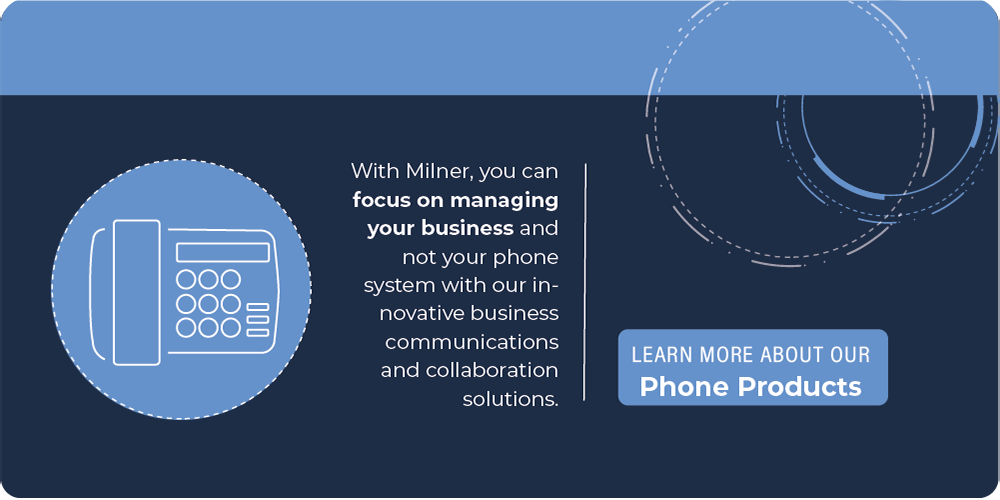Making the switch from one kind of technology to another, more modern technology can feel daunting. Updating the systems that run your office infrastructure always poses security, cost, and scalability concerns. If the change is driven by necessity rather than preference, and especially if it is time-bound, it can feel even more overwhelming. Milner is your trusted friend in the migration away from decommissioned copper POTS lines.
Many of the major infrastructures that power our offices are connected by phone lines, and the national phone network has been powered by copper wire since the 1880s. However, in response to newer technologies such as fiber optics, mobile, and cellular technologies, companies no longer need or want outdated copper line infrastructure. The Federal Communications Commission now views these analog phone lines as obsolete and unsustainable, issuing a mandate to terminate copper lines. Most major telephone providers like AT&T, Verizon, Lumens and others will begin replacing the over 36 million active plain old telephone systems (POTS) lines with fiber and wireless connections in 2022. In other words, if you still use POTS or other copper-based services, you need to begin to sundown them as quickly as possible.
What is POTS and why is it being decommissioned?
Plain old telephone systems (POTS) refer to copper wires used for analog voice transmission and have been around for nearly a century. While not all copper lines are that old, the technology is becoming less reliable and more expensive as traditional phone lines age. In contrast, fiber and wireless offer more in the way of options and digital capabilities. According to the FCC, the number of POTS lines in the U.S. declined from 122 million in 2010 to 41 million in 2019. Many carriers are planning to drop POTS lines in the next few years.
The end of “analog-era” POTS will have an effect on several different systems that rely on these copper wire-based networks such as fire and security alarms, phone and voice adapters, point-of-sale (POS) systems, elevators, gate access systems, ATMs, as well as traditional fax machines and systems. However, by replacing any technology that relies on POTS now, you can avoid the potential downtime caused by the FCC mandate, avoid vaguely defined SLAs, and reduce the frequency of audits that might raise costs. With the switch to a modern service, you’ll receive continuity in support and security, as well as save money and future-proof your business technology.
What steps should you take?
Take stock of your inventory
The first thing you will need to do is an inventory of your systems to figure out which of your devices will be directly affected by the decommission of copper lines. First, contact your phone service provider to find out if your phone line is a traditional analog phone line or if it is a Voice over Internet Protocol (VoIP) line.
Visibility into your inventory can be gained by categorizing it by type, and linking it to locations, invoices, contracts, cost centers, departments, vendors, orders, and employees – across all carriers. Additionally, you can find out where the lines are located, who is using them, and how much it is costing. It is our business technology experts’ job to identify which of your business’s technologies will be affected by the change and how you should proceed. If you’re not sure where to start, contact Milner.
Switch to any digital alternatives
Once your inventory has been completed, get rid of the phone lines you no longer need, those that are infrequently used, or those that can be replaced with digital alternatives that are more cost effective. As POTS lines have traditionally provided the structural framework for fax machines, this is probably the first place you should look to switch to newer, digital cloud alternatives.
As with POTS lines, IDSN lines will also be sunset due to the use of copper lines. Currently, IDSN lines are used only by a few people in the radio industry and are not as common as POTS lines. However, the solution remains the same: switching to a VoIP option, which offers a cheap alternative to any phone system.
Reach out to Milner for help
Start planning and strategizing now before your POTS-connected technology is sunsetted. Consider converting your POTS or PRI line to SIP if you have more than 10 phone lines. Your current phone system can be switched out for a cloud-based UC or UCaas system. Multi Protocol Label Switching (MPLS) can be used to network your offices. Feeling lost in acronyms? Our business technology experts can help you make data-driven decisions that are right for your company and its particular technology usage.
Technology changes, and while copper phone infrastructure may soon be in our rear-view mirror, we’re always here to help you master the exciting new digital road you’re on. If you are a Milner client, please reach out to your Account Manager who can help you through this process!

